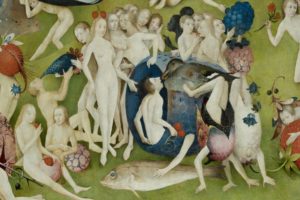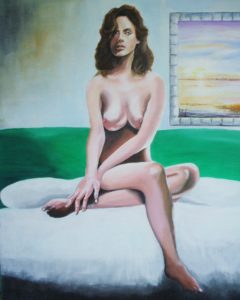Love, sex and death are some of the most frequently explored themes featuring naked or partially covered bodies in the history of western art and music. Venus, Adam and Eve, naked Gods and Godesses, reclining female nudes, seduction and even rape have been regularly featured in visual art history and composers and songwriters have also been compelled to write about similar material including love, forbidden relationships, seduction, sex and death. The Venus of Villendorf, The Birth of Venus (Botticelli), The Venus of Urbino (Titian), The Rokeby Venus (Valesquez), The Naked Maja (Goya), Olympia(Manet), The Three Graces (Raphael, Rubens), Tarquin and Lucretia (Titian), Samson and Delilah (Rubens), Salome (Moreau) are just a few examples of this kind of subject matter. Many of the renaissance paintings of these subjects are full of symbolism and more recent ones, particularly in the last three centuries, have been much more explicit with Courbet, Egon Schiele, Salvador Dali, Stanley Spencer, Tracy Emin and many others causing shock and outrage in their treatment of this material.
In classical music it’s probably the Last Judgement which has preoccupied most creators in the many requiem masses that have have been written by such composers as Mozart, Beethoven, Rossini and Verdi. This event is usually in the Dies Irae sections of these works where the focus is on heaven and hell. It is the idea of eternal damnation in hell where art and music are closely connected and in art it was constantly visualised by the Italian Renaissance masters, the most famous of all versions probably being by Michelangelo in the Sistine Chapel. Apart from the Italian Renaissance interpretations which contain an abundance of nudity, the northern Renaissance painter Hieronymous Bosch from the Netherlands produced a particularly grotesque collection of images contained in a Tiptych. One of these panels “The Garden of Earthly Delights” inspired Michael Berkeley to compose a complete orchestral work based on its content of strange figures and mysterious creatures. It includes musical references to carnal knowledge and the retribution of hell and there is a wild accelerating dance interrupted by sinister pauses. The finale, according to the composer, describes ‘the overwhelming voice of judgement.

Part of “The Garden of Earthly Delights” by Bosch
The most striking Dies Irae yet written in music is probably in the Verdi requiem which is arguably the most dramatic, powerful and fearsome one that I know with an electrifying introduction. The first few bars are a real shock to the system!
Several stories from the bible dealing with infatuation, seduction and death have also been dealt with by composers and artists, perhaps the most prominent being Samson and Delilah (Rubens and Rembrandt in art and Handel and Saint-Saens in music). There are modern versions too by the Grateful Dead plus Les Reed and Barry Mason’s Delilah written for Tom Jones which, although rooted in lust, is not derived from the biblical tale. The New Testament story of the temptress Salome and her obsession with John the Baptist (Carravaggio, Reni and Moreau in art and Richard Strauss in his opera) is also a popular subject dealing with lust, a demand for the head of the prophet brought to Salome on a platter (as a reward for her dance of the seven veils) and her ultimate death.
Both the biblical accounts deal with seduction, lust, femmes fatales, and the eventual death of key characters. Much of the art involves varying degrees of semi-nudity and totally naked male and female forms. In a broader context there have been many versions of the reclining female nude some, rather coy where the subject does not gaze at the viewer, such as the Rokeby Venus by Velasquez. Others, however, like the Venus of Urbino by Titian and Manet’s Olympia are more provocative and brazenly stare straight at the onlooker.
I’m trying at the moment to depict in a new painting a much less threatening nude female compared with the kind mentioned above who is looking at the viewer in a romantic, slightly sexy, and totally un -intimidating way set against a restful, serene background. Much work is still required!
The biggest technical challenge for me with this subject is the flesh painting and achieving a seamless transition from light to dark whilst maintaining accurate flesh tones and anatomical structure. The style is fairly tight and traditional and, whilst I’m not aiming for photo-realism, I do want to obtain depth, accuracy, and credibility. I also want to create a feeling of calm serenity both in the woman featured and the surrounding space, particularly the background view through the window. Many decisions need making and as you may have guessed I’m only concerned with love and beauty here and not temptation, lust, sex and death! …….two days later and now nearing completion:-

There is so much more to be explored on the links between art and music that I’ve decided to devote my next blog to ‘painting (musical) sound which will deal with popular music and has been sparked off by a new television series on the history of recorded music.